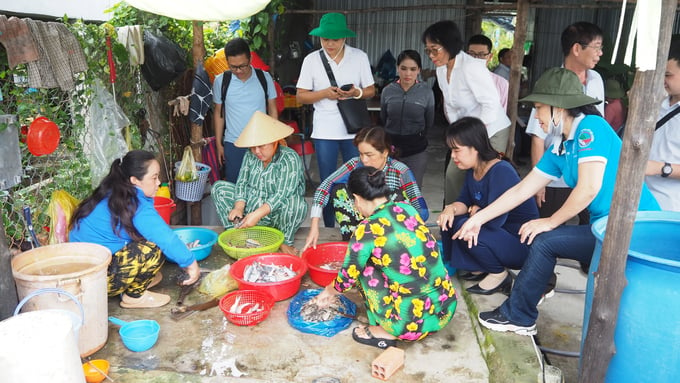November 27, 2025 | 05:42 GMT +7
November 27, 2025 | 05:42 GMT +7
Hotline: 0913.378.918
November 27, 2025 | 05:42 GMT +7
Hotline: 0913.378.918

The project "Protecting the climate and mangroves combined with income improvement for vulnerable communities" is implemented in the area of Ca Mau Cape National Park and Tam Giang Protection Forest Management Board. Photo: Trong Linh.
"Protecting climate and mangroves combined with income improvement for vulnerable communities" is a project implemented by the Center for Sustainable Rural Development in the area of Ca Mau Cape National Park and Ca Mau’s Tam Giang Protection Forest Management Board.
The project aims to strengthen biodiversity protection, develop mangrove forests, contribute to promoting carbon sequestration, enhance climate resilience, ensure sustainable livelihoods and social inclusion for poor and vulnerable communities in the Mekong Delta.
Mr. Tran Van Thuc, Deputy Director of Ca Mau Department of Agriculture and Rural Development, highly regarded the project's success as well as the achieved results during the two years running the project. Thanks to the support and good coordination of the Department of Agriculture and Rural Development, stakeholders and people in the locality, the project has brought many positive impacts on the forest management and protection work as well as the development of livelihoods for those living in the national park and protection forest management staff.

After 2 years of implementation, the project has helped the Forest Management Board to propagate and coordinate forest management and protection, thereby improving people's living conditions. Photo: Trong Linh.
Mr. Ly Minh Kha, Deputy Director of Ca Mau Cape National Park, said, “In my perspective, the project's activities in the second year have been much more efficient, helping U Minh Ha National Park in its work of information dissemination, coordination in forest management and protection. As a result, people's livelihoods are improved. In particular, the 2-phase shrimp model has received a lot of positive response from the people, initial replication has shown good results."
Having achieved such results, Mr. Kha highly appreciated the efforts of the project staff from the SRD center and the Women's Union of Ca Mau during the implementation at localities. In the near future, Ca Mau Cape National Park will continue to work with relevant units to have assessments, adjust restrictions, be ready to coordinate and deploy meaningful activities as a response to the project’s progress and responsibility to the people in the project area.

After 2 years of implementing the project, people’s responsibility in coordination, management and protection of mangroves has been significantly improved. Livelihood models under the forest canopy open up a number of new directions in household economic development for communities living near the forests. Photo: Trong Linh.
“The project's activities have contributed to raising awareness and responsibility for forest protection among the members of seven forestry groups and local people living in the forest area. In 2022, the project supported the management board to plant 5 ha of new forest and an additional 27 ha of mangroves. These areas will have great significance to forest restoration and development work in the future,” said Mr. Nguyen Quang Khai, deputy head of the Tam Giang Protection Forest Management Board.
After 2 years of implementing the project, people’s responsibility in coordination, management and protection of mangroves has been significantly improved. Livelihood models under the forest canopy open up a number of new directions in household economic development for communities living near the forests.
There remain a number of livelihood models that are not effective due to increasingly erratic weather conditions, leading to risks during the piloting of livelihood models. Despite certain difficulties, the project still provides sufficient assistance and contribution to raising awareness about forest protection and finding sustainable livelihood solutions. Thanks to the project, people with conditions for economic development under the mangrove canopy can have more chances to increase their income and better their living conditions.
Director of the Center for Sustainable Rural Development Vu Thi Bich Hop said, “In the coming period, it is deemed essential to continue to maintain the good progress after two years of implementing the project and make full use of the achieved results. The project will particularly focus on objectives related to forest protection and development, enhancement of mangrove carbon stocks, and policy advocacy plus livelihood improvement. The project’s achievements can be considered a great condition for the project to propose further support from sponsors to implement activities in the next phase.”
Translated by Samuel Pham
/2025/11/26/4909-2-154329_878.jpg)
(VAN) Pearl grouper farming in HDPE cages not only delivers economic efficiency but also contributes to protecting the environment, creating jobs, and promoting marine-based experiential tourism.

(VAN) The model of making a living under the forest canopy through the agroforestry system in Van Son commune, Bac Ninh province, is expected to generate an annual income of approximately VND 30 million/ha.

(VAN) Many enterprises in Can Tho are harnessing natural energy and reducing greenhouse gas emissions in their production processes, thereby contributing to the promotion of a sustainable green transition.
/2025/11/24/3536-2-112800_176.jpg)
(VAN) Dong Nai now has tens of thousands of hectares of forests certified for sustainable management, and this area will continue to be expanded in the coming period.

(VAN) Vinh Ha hamlet (Dai Xuyen commune, Hanoi) is shifting away from small-scale farming as households adopt bioscurity into their breeder chicken models.

(VAN) Heavy rains make aquatic species more vulnerable to disease. Proactive water management and high-tech systems help farmers prevent outbreaks and protect yields.

(VAN) Greenhouses are shifting production mindsets in Binh Lu commune, enabling farmers to ‘weather the sun and rain’ and secure stable vegetable harvests throughout the year.